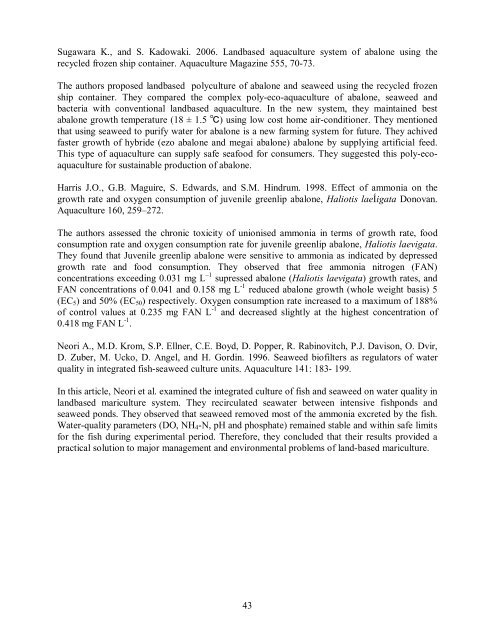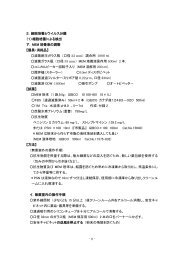Program and Abstracts(PDF)
Program and Abstracts(PDF)
Program and Abstracts(PDF)
Create successful ePaper yourself
Turn your PDF publications into a flip-book with our unique Google optimized e-Paper software.
Sugawara K., <strong>and</strong> S. Kadowaki. 2006. L<strong>and</strong>based aquaculture system of abalone using the<br />
recycled frozen ship container. Aquaculture Magazine 555, 70-73.<br />
The authors proposed l<strong>and</strong>based polyculture of abalone <strong>and</strong> seaweed using the recycled frozen<br />
ship container. They compared the complex poly-eco-aquaculture of abalone, seaweed <strong>and</strong><br />
bacteria with conventional l<strong>and</strong>based aquaculture. In the new system, they maintained best<br />
abalone growth temperature (18 ± 1.5 ℃) using low cost home air-conditioner. They mentioned<br />
that using seaweed to purify water for abalone is a new farming system for future. They achived<br />
faster growth of hybride (ezo abalone <strong>and</strong> megai abalone) abalone by supplying artificial feed.<br />
This type of aquaculture can supply safe seafood for consumers. They suggested this poly-ecoaquaculture<br />
for sustainable production of abalone.<br />
Harris J.O., G.B. Maguire, S. Edwards, <strong>and</strong> S.M. Hindrum. 1998. Effect of ammonia on the<br />
growth rate <strong>and</strong> oxygen consumption of juvenile greenlip abalone, Haliotis laeÍigata Donovan.<br />
Aquaculture 160, 259–272.<br />
The authors assessed the chronic toxicity of unionised ammonia in terms of growth rate, food<br />
consumption rate <strong>and</strong> oxygen consumption rate for juvenile greenlip abalone, Haliotis laevigata.<br />
They found that Juvenile greenlip abalone were sensitive to ammonia as indicated by depressed<br />
growth rate <strong>and</strong> food consumption. They observed that free ammonia nitrogen (FAN)<br />
concentrations exceeding 0.031 mg L –1 supressed abalone (Haliotis laevigata) growth rates, <strong>and</strong><br />
FAN concentrations of 0.041 <strong>and</strong> 0.158 mg L -1 reduced abalone growth (whole weight basis) 5<br />
(EC 5 ) <strong>and</strong> 50% (EC 50 ) respectively. Oxygen consumption rate increased to a maximum of 188%<br />
of control values at 0.235 mg FAN L -1 <strong>and</strong> decreased slightly at the highest concentration of<br />
0.418 mg FAN L -1 .<br />
Neori A., M.D. Krom, S.P. Ellner, C.E. Boyd, D. Popper, R. Rabinovitch, P.J. Davison, O. Dvir,<br />
D. Zuber, M. Ucko, D. Angel, <strong>and</strong> H. Gordin. 1996. Seaweed biofilters as regulators of water<br />
quality in integrated fish-seaweed culture units. Aquaculture 141: 183- 199.<br />
In this article, Neori et al. examined the integrated culture of fish <strong>and</strong> seaweed on water quality in<br />
l<strong>and</strong>based mariculture system. They recirculated seawater between intensive fishponds <strong>and</strong><br />
seaweed ponds. They observed that seaweed removed most of the ammonia excreted by the fish.<br />
Water-quality parameters (DO, NH 4 -N, pH <strong>and</strong> phosphate) remained stable <strong>and</strong> within safe limits<br />
for the fish during experimental period. Therefore, they concluded that their results provided a<br />
practical solution to major management <strong>and</strong> environmental problems of l<strong>and</strong>-based mariculture.<br />
43



